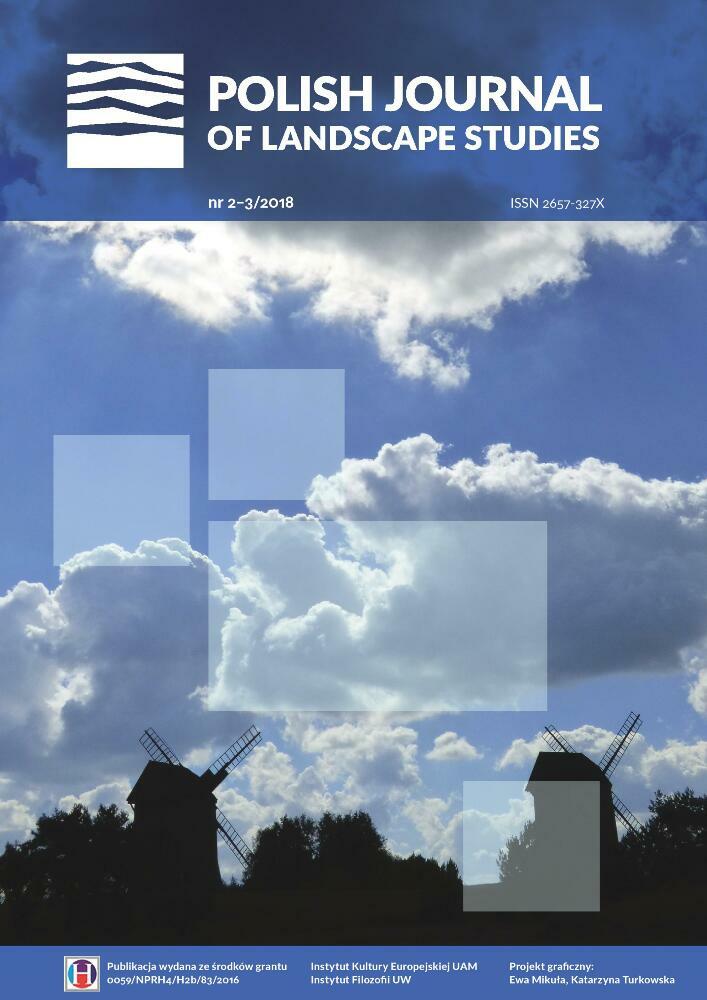Abstract
The aim of the paper is to characterize contemporary transformation of urban greenery, which rely on the image of garden in order to arrive at a “garden-like” character of the cityscape. It also demonstrates how the image of garden is applied in the city as a new tool of social communication in the course of democratic transformation of the urban space. The author discusses the origins of the garden-image and the “garden-like” character of space, providing examples of how it is used today in the cityscape by the inhabitants, activists, designers and artists. The text introduces a range of informal, Polish projects of urban gardens and spaces drawing on its image, describing their novel role in building the vernacular landscape of a city.References
Berleant, Arnold. 1997. Living in the Landscape: Toward an Aesthetics of Environment. Lawrence: University Press of Kansas.
Chase, John L., Margaret Crawford, and John Kaliski. 2008. Everyday Urbanism. New York: Monacelli.
Cosgrove, Denis E. 2014. “Krajobraz i europejski zmysł wzroku—przyglądanie się naturze” [“Landscape and the European Sense of Sight—Eyeing Nature”]. Translated by Beata Frydryczak. In Krajobrazy. Antologia tekstów [Landscapes: An Anthology], edited by Beata Frydryczak and Dorota Angutek, 79—110. Poznań: Wydawnictwo PTPN.
Bellini, Amadeo. 1992. “Difficoltà teoriche nel restauro dei giardini storici.” In Il giardino e il tempo. Conservazione
e manutenzione delle architetture vegetali, edited by Maurizio Boriani and Lionella Scazzosi. Milano: Guerini e Associati.
Foster, Sheila. 2016. “The Co-City: From the Tragedy to the Comedy of the Urban Commons.” The Nature of Cities (blog). November 2. http://www.thenatureofcities.com/2016/11/02/the-co-city-from-the-tragedy-to-the-comedy-of-the-urban-commons/?utm_source=feedburner&utm_medium-=email&utm_campaign=Feed%3A+TheNatureOfCities+%28The+Nature+of+Cities%29.
Gawryszewska, Beata J. and Łukasz Guzek. 2002. “Ogród rodzinny i performance” [“Family Garden and Performance]. Przyroda i miasto 4: 101—5.
Gawryszewska, Beata J. 2004. “Modernizować modernizm? Zielone dziedzińce Czerwonego Żoliborza w programie rewitalizacji przestrzeni społecznej osiedla WSM” [“Is Modernism to Be Modernised? Green Yards of Red Żoliborz in the Program for Revitalizing Social space at the WSM district”]. Przyroda i miasto 6: 57—72.
Gawryszewska, Beata J. 2008. Historia i struktura ogrodu rodzinnego[The History and Structure of the Family Garden]. Warsaw: SGGW.
Gawryszewska, Beata J. 2013. Ogród jako miejsce w krajobrazie zamieszkiwanym [The Garden as a Place in an Inhabited Landscape]. Warsaw: Wieś Jutra.
Gawryszewska, Beata J. and Izabela Myszka-Stąpór. 2016. “Ogrody towarzyszące zamieszkiwaniu w procesach rewitalizacji i redefiniowaniu przestrzeni miejskich” [“Gardens Accompanying Habitation in Revitalizing Processes and Redefining Urban Spaces”]. Prace Komisji Krajobrazu Kulturowego 32: 71—82.
Harvey, David. 2012. Rebel Cities: From the Right to the City to the Urban Revolution. London: Verso.
Jackson, John B. 1984. Discovering the Vernacular Landscape. New Haven: Yale University Press.
Krajewski, Marek. 2013. Niewidzialne miasto [Invisible City]. Warsaw: Fundacja Bęc Zmiana.
Latour, Bruno. 2009. Polityka natury [Politics of nature]. Translated by Agatha Czarnacka. Warsaw: Wydawnictwo Krytyki Politycznej.
Łepkowski, Maciej, Ryszard Nejman, and Anna Wilczyńska. 2016. “The Role of Green Urban Wastelands in 3rd Place Creation: Challenge for Urban Policy in Poland”. In Landscapes and Greenways of Resilience, Proceedings of 5th Fabos Conference on Landscape and Greenway Planning, edited by Sándor Jombach, IstvánValanszki, Krisztina Filep-Kovacs, Julius Gy. Fabos, Robert L. Ryan, Mark Lindhult and LászlóKollanyi, 45—53. Budapest: Szent István Egyetem.
Montgomery, Charles. 2015. Miasto szczęśliwe. Jak zmienić nasze życie, zmieniając nasze miasta [Happy City: Transforming Our Lives Through Urban Design]. Translated by Tomasz Tesznar. Kraków: Wydawnictwo Wysoki Zamek.
Myszka-Stąpór, Izabela and Beata J. Gawryszewska. 2013. “Logicznie i symbolicznie. O projektowaniu proaktywnym w Bolestraszycach” [“Logically and Symbolically: On Proactive Design in Bolestraszyce”]. Sztuka ogrodu. Sztuka krajobrazu 1 (5): 113—9.
Oldenburg, Ray. 1996/1997. “Our Vanishing ‘Third Places’.” Planning Commissioners Journal 25: 6—10.
Prominski, Martin. 2016. “Designing Landscapes as Evolutionary Systems.” The Design Journal 8 (3): 25—34.
Salwa, Mateusz. 2016. Estetyka ogrodu. Między sztuką a ekologią [Garden Aesthetics: Between Art and Ecology]. Łódź: Przypis.
Szafrańska, Małgorzata. 2011. Człowiek w renesansowym ogrodzie [Man in a Renaissance Garden]. Kraków: Miniatura.
Rymkiewicz, Jarosław. 2010. Myśli różne o ogrodach [Thoughts on Gardens]. Warsaw: Wydawnictwo Sic!.
Winiarska-Lisiecka, Edyta Z. 2016. Podwórka jako ogrody wspólnot sąsiedzkich [Yards as Neighbors’ Community Gardens]. PhD diss., Warsaw University of Life Sciences.

